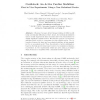Free Online Productivity Tools
i2Speak
i2Symbol
i2OCR
iTex2Img
iWeb2Print
iWeb2Shot
i2Type
iPdf2Split
iPdf2Merge
i2Bopomofo
i2Arabic
i2Style
i2Image
i2PDF
iLatex2Rtf
Sci2ools
107
Voted
MICCAI
2007
Springer
2007
Springer
Cardiolock: An Active Cardiac Stabilizer
Off-pump Coronary Artery Bypass Grafting (CABG) is still today a technically difficult procedure. In fact, the mechanical stabilizers used to locally suppress the heart excursion have been demonstrated to exhibit significant residual motion. We therefore propose a novel active stabilizer which is able to compensate for this residual motion. The interaction between the heart and a mechanical stabilizer is first assessed in vivo on an animal model. Then, the principle of active stabilization, based on the high speed vision-based control of a compliant mechanism, is presented. In vivo experimental results are given using a prototype which structure is compatible with a minimally invasive approach.
Mechanical Stabilizer | Medical Imaging | MICCAI 2007 | Off-pump Coronary Artery | Significant Residual Motion |
| Added | 14 Nov 2009 |
| Updated | 14 Nov 2009 |
| Type | Conference |
| Year | 2007 |
| Where | MICCAI |
| Authors | Wael Bachta, Pierre Renaud, Edouard Laroche, Jacques Gangloff, Antonello Forgione |
Comments (0)

